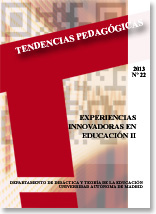FROM EDUCATIONAL VIDEO TO MULTIMEDIA LEARNING OBJECTS INTERACTIVE: A COLLABORATIVE LEARNING ENVIRONMENT BASED ON SOCIAL NETWORKS
Keywords:
Educational video, Interactivity, Learning by Design, Social Network, Computersupported collaborative learning.Abstract
The multimedia resources, in particularly the video media, have been used in several learning experiences, which have shown that they are relevant for supporting educational material in teaching-learning processes. However, traditional methods of creating and editing multimedia content are expensive and complex and they don't allow to be implemented as a generalized practice for teaching. We propose collaborative methods for reusing resources, to allow the composition of Multimedia-interactive Learning Objects supported by an open environment called Social Web Media Learning (SMLearning). This paper describes this environment and presents a summary of some experiences carry out, both with students of graduate and postgraduate courses, in the context of Educational Development Projects at Universidad Autónoma de Madrid.Downloads
References
Barkley, E., Cross, K., Howell, C. (2007), Técnicas de aprendizaje colaborativo: manual para el profesorado universitario, Ediciones Morata, 165-167.
Bravo, JL. (1996) ¿Qué es el vídeo educativo? Comunicar, 6. 100-105.
Bryndum, S., & Montes, J. A. (2005). La motivación en los entornos telemáticos. RED: Revista de Educación a Distancia, 13.
Burden, K., & Atkinson, S. (2008). Evaluating pedagogical affordances of media sharing Web 2.0 technologies: A case study. In Proceedings of ascilite, Melbourne.
Claros, I., & Cobos, R. (2012a). An approach for T-learning content generation based on a social media environment. In Proceedings of the 10th European
conference on Interactive TV and video, ACM, 157-160.
Claros, I., & Cobos, R. (2012b). User interaction analysis in a CSCL environment supported by social media technologies. In Proceedings of the 13th International Conference on Interacción Persona-Ordenador, ACM, 20
Claros, I., & Cobos, R. (2013) Pautas para la implementación de Analíticas de Aprendizaje en Entornos Colaborativos Centrados en la Interacción Social. XV Simposio Internacional de Tecnologías de la Información y las Comunicaciones en la Educación, 2(3), 4.
Dillon, A. & Gabbard, R. (1998). Hypermedia as an educational technology: A review of the quantitative research literature on learner comprehension, control
and style. Review of Educational Research, 68(3), 322-349.
Echeverria, L., & Cobos, R. (2010). A Motivation Booster proposal based on the monitoring of users´ progress in CSCL environments. In Computer Supported
Cooperative Work in Design (CSCWD), 2010 14th International Conference on IEEE, 671-676.
Fuller,R. & Lang, C. (Eds) (1992). Videodiscs produced by American Association of Physics Teachers. Physics: Cinema Classics
Gardner, D. (1994). Student-produced video documentary: Hong Kong as a self-access resource. Hong Kong: Papers in Linguistics and Language
Teaching, 17, 45-54.
Garmendía, A. & Cobos, R., 2013. Towards the Extension of a LMS with Social Media Services. In Y. Luo, ed. Cooperative Design, Visualization, and Engineering SE – 11, Springer Berlin Heidelberg, 67-72.
Harness, H., & Drossman, H. (2011). The environmental education through filmmaking project. Environmental Education Research, 17(6), 829-849.
Kaplan A., Haenlein M. (2010) “Users of the world, unite! The challenges and opportunities of social media”, Business Horizons, 53(1), 59-68.
Kearney, M., & Treagust, D. F. (2001). Constructivism as a referent in the design and development of a computer program using interactive digital video to enhance learning in physics. Australian: Journal of Educational Technology, 17(1), 64-79.
Madian, J. (1995). Multimedia - why and why not? The Computing Teacher, 22(5), 16-18.
Markus, H. R., & Kitayama, S. (1991). Culture and the self: Implications for cognition, emotion, and motivation. Psychological Review; Psychological Review, 98(2), 224.
Masats, D., Dooly, M., & Costa, X. (2009). Exploring the potential of language learning through video making. In Proceedings of EDULEARN09 Conference. Valencia, Spain: International Association of Technology, Education and Development (IATED).
McMillan, S. J. (2006). Exploring models of interactivity from multiple research traditions: Users, documents, and systems. Handbook of new media: Social
shaping and consequences of ICTs, 205-229.
Moreno, R., Mayer, R., (2007) “Interactive Multimodal Learning Environments”, Educ Psychol Rev, 19, 309-326.
Muñoz-Repiso, A. G. V. (2008). Medios y recursos audiovisuales para la innovación educativa. Investigación y tecnologías de la información y
comunicación al servicio de la innovación tecnológica, 145, 57.
Puntambekar, S., Stylianou, A., & Hübscher, R. (2003). Improving navigation and learning in hypertext environments with navigable concept maps. Human
Computer Interaction, 18, 395-428
Rouet, J. (2006). The skills of document use. Mahwah, NJ: Erlbaum.
Rouet, J., & Potelle, H. (2005). Navigational principles in multimedia learning. In R. Mayer (Ed.), Cambridge handbook of multimedia learning New York,
Cambridge University Press. 297-312.
Salomon, G., Perkins, D. N., & Globerson, T. (1991). Partners in cognition: Extending human intelligence with intelligent technologies. Educational researcher, 20(3), 2-9.
Schmidt, M. (1987) Cine y vídeo educativo. Madrid: Ministerio de Educación y Ciencia.
Schwartz, D. L., & Hartman, K. (2007). It is not television anymore: Designing digital video for learning and assessment. Video research in the learning
sciences, 335-348.
Zollman, D. A., & Fuller, R. G. (1994). Teaching and learning physics with interactive video. Physics Today, 47, 41.
